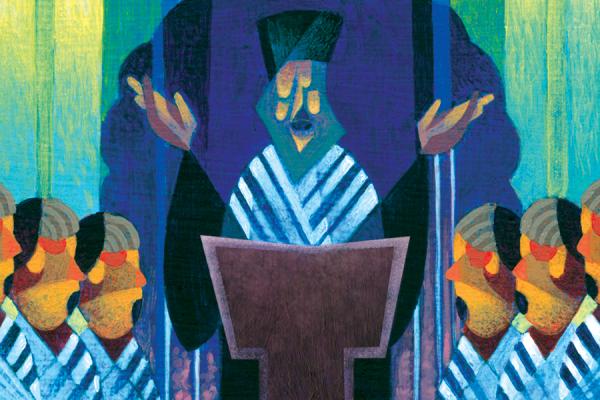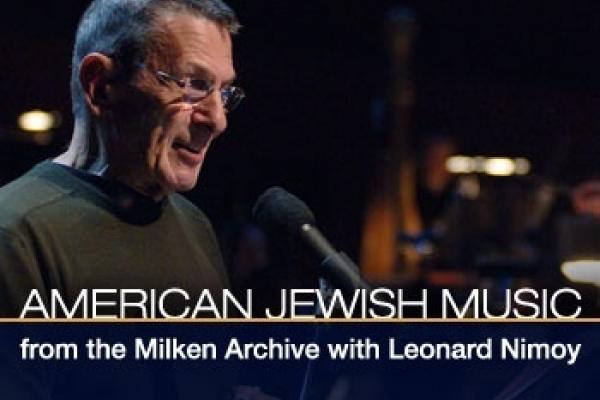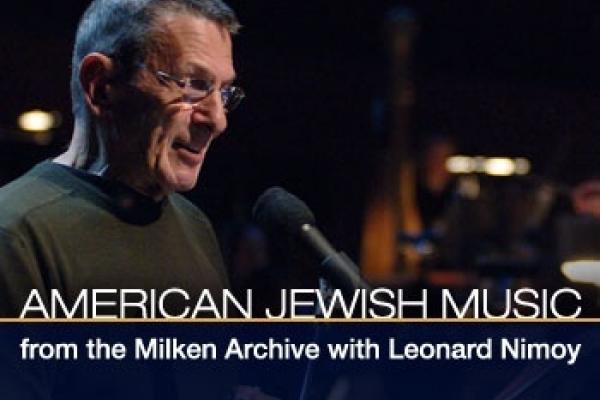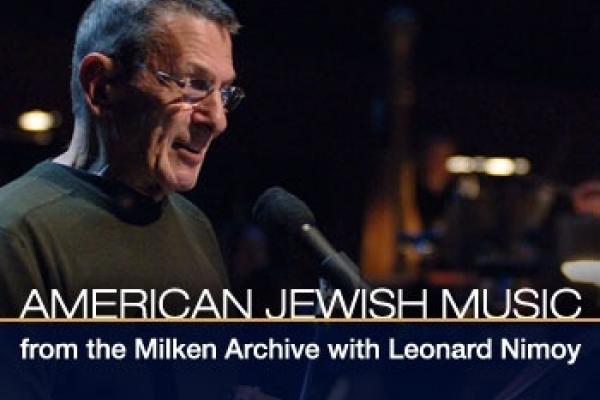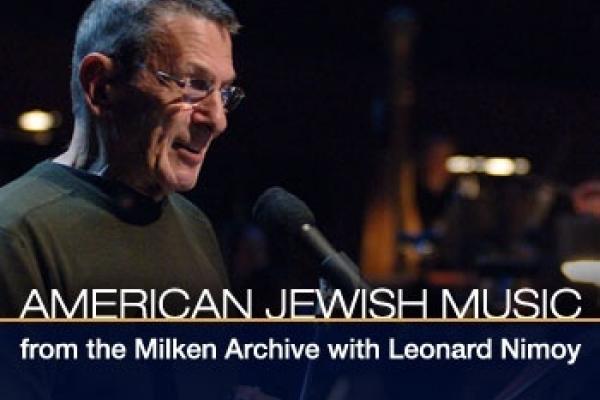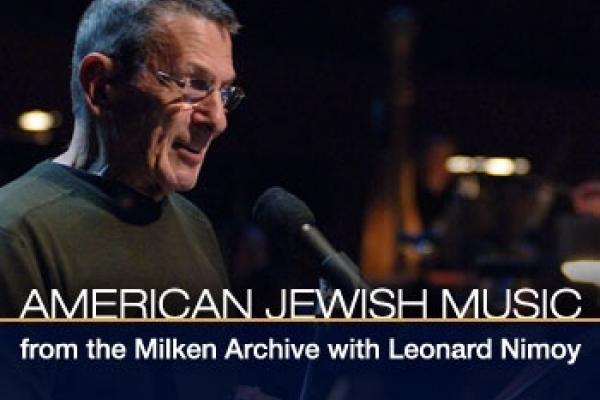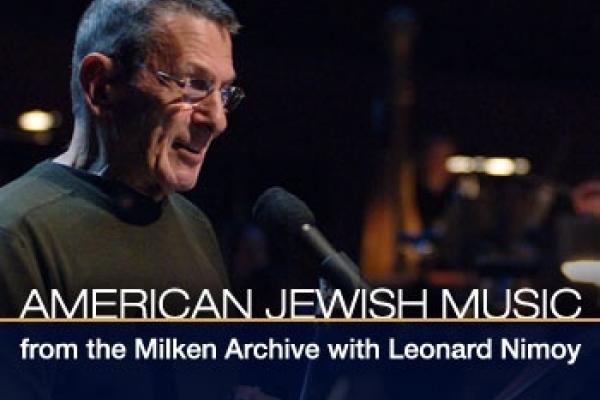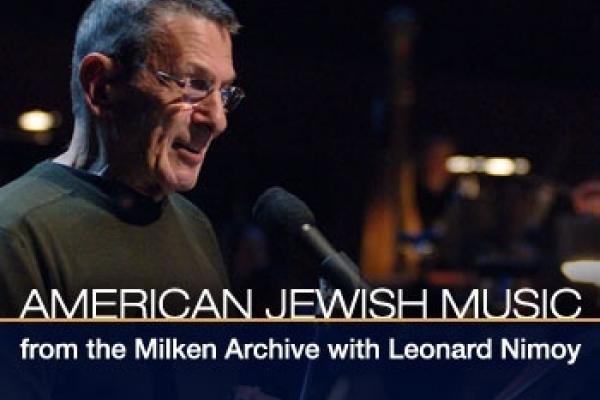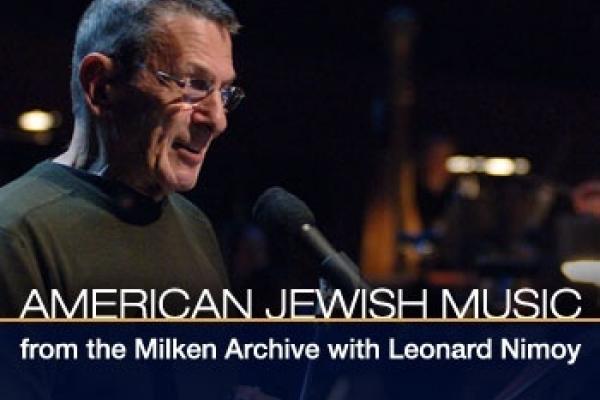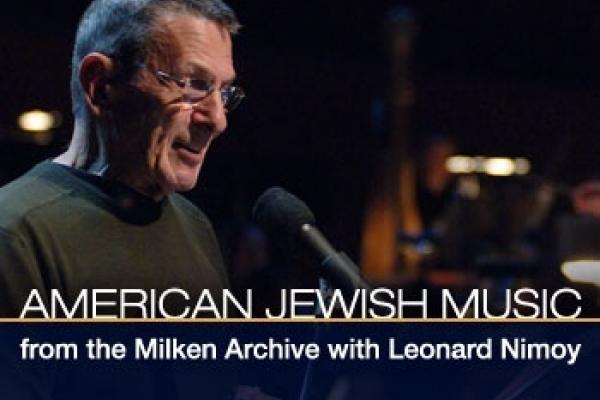Episode 10: Legends
Click on the ![]() icon on the top-right of the video to access the full playlist.
icon on the top-right of the video to access the full playlist.
From the biblical story of Naomi and Ruth, to the medieval legend of the golem of Prague and the parables of Rabbi Nahman of Bratslav, this episode includes musical treatments of some of the great stories in Jewish literature.
Episode Transcript
Leonard Nimoy
The line between fact and fiction – between history and legend – is often blurred, sometimes even indistinct. A gripping drama will be told from generation to generation if it continues to hold meaning, whether the story is pure legend, or comes from the pages of history. Sometimes those stories are also told through music.
Leonard Nimoy
Hello, I’m Leonard Nimoy. Welcome to another program in a 13-part series that celebrates three and a half centuries of uninterrupted Jewish life in the United States through music, as documented by the Milken Archive of American Jewish Music, and issued on CD on the Naxos label. On today’s program: compositions inspired by Jewish tales from folklore, history, and the Bible.
Leonard Nimoy
One composer who was often inspired by literary sources is Mario Castelnuovo-Tedesco. Gerard Schwarz, music director of the Seattle Symphony and a member of the Milken Archive's editorial board, spoke with Neil Levin, artistic director of the Milken Archive, about that composer's work entitled Naomi and Ruth.
Gerard Schwarz
Mario Castelnuovo-Tedesco's greatest influence, besides his background in Judaism with Shakespeare. When we think of talking about this wonderful composer and extraordinary music that he wrote, we have his Naomi and Ruth to begin our program.
Neil Levin
Yeah, I think the Shakespeare interest is not inconsistent with the interest in the Bible, which was his other major interest, because without any considerations of truth or accuracy or history, as opposed to story, there is great theater in much of the Bible, and in particular in some of the stories, such as Naomi and Ruth. This is a particularly touching incident in the Bible. It's inspired many, many composers. The idea that Ruth says to her mother in law, I think it was...I have become part of your people and even though you say it's no longer necessary for me to be a Jew, No no, I want to be where you go, I will go.
Neil Levin
It's the model for a genuine conversion to Judaism. But this is a very tender and touching account of that story.
Leonard Nimoy
Mario Castelnuovo-Tedesco composed this cantata in 1947, eight years after he left his native Italy, when it had succumbed to Fascist control, and established himself as a leading composer of film scores in Hollywood. Here is Castelnuovo-Tedesco’s “Naomi and Ruth,” performed in a Naxos release by soprano Ana Maria Martinez with the Academy and Chorus of St. Martin-in-the-Fields conducted by Neville Marriner.
Naomi & Ruth by Mario Castelnuovo-Tedesco
Leonard Nimoy
The cantata “Ruth and Naomi,” based on the Biblical Book of Ruth -- music of Mario Castelnuovo-Tedesco. In a Milken Archive recording released on a Naxos CD, Sir Neville Marriner led the Academy and Chorus of St. Martin-in-the-Fields. The soprano soloist was Ana Maria Martinez.
Leonard Nimoy
You’re listening to music inspired by Jewish legends on this program from the Milken Archive.
Leonard Nimoy
Another Biblical story was the basis for an orchestral work by the little-known composer Jan Meyerowitz. It’s entitled “Midrash Esther.” Neil Levin tells Gerard Schwarz about this composer and a pivotal moment in his life.
Gerard Schwarz
Meyerowitz wrote about the midrash. What is the midrash?
Neil Levin
Midrash means teaching through legends. There is the midrash, which is a literature, and there are some specific books that make up the midrash, which explicates and amplifies upon the Torah and other Judaic aspects and law and so forth through story, not necessarily true story through metaphors. It has been described as the heart and soul, as opposed to the brain of Jewish explicatory literature.
Neil Levin
So this is a musical midrash, a musical amplification on the story of Esther, which is read annually on the festival of Purim, which celebrates the victory over the enemies of Jewry in the ancient Persian empire, who had arranged and organized and all but succeeded in carrying out a genocide, not just of the Jews in Persia, but the Jews throughout the Persian Empire, which at that time extended all the way to India.
Neil Levin
And Meyerowitz was interested in this subject in many different ways. This is not the only composition he wrote about Esther. He also wrote an opera on the same subject. But this is really interesting because he did not even know that he was Jewish until he was a grown man, because his parents both hid it from him. One of the revelatory experiences for him was he was on a train and he did not yet know that he was a Jew. And the German soldiers took off all the Jews whom they identified, of course, because they were circumcised and he wasn't, and shot them right in front of the train. The interesting analogy here, and this is just guesswork, is in the story of Esther. Remember that Esther, who is agilis, marries the king of Persia, and Mordecai advises her not to let the king know that she is Jewish. And then she risks her life, in a way, when she goes to the king and she says, I have to tell you, you inadvertently or foolishly signed or approved, that tomorrow is going to murder all Jews. And you may not care except for something I have to tell you I'm Jewish. And that's essentially the story of Esther. Now, whether Meyerowitz's fascination with that is connected to that, it's up to us to guess.
Leonard Nimoy
Music historian and musicologist Neil Levin, in a conversation recorded for this series. Here is the fourth movement of Jan Meyerowitz’s symphony “Midrash Esther,” entitled “Purim” – the Jewish holiday that celebrates the deliverance of the Jews from genocide as described in the Biblical Book of Esther. Yoel Levi conducts this performance by the Berlin Radio Symphony Orchestra.
Symphony Midrash Esther by Jan Meyerowitz
Leonard Nimoy
“Purim” – named for the festive Jewish holiday of that name – from a symphony entitled “Midrash Esther,” by Jan Meyerowitz, who died in 1998. This musical retelling of the Biblical Book of Esther was performed by the Berlin Radio Symphony Orchestra, Yoel Levi conducting, from a Naxos CD.
Leonard Nimoy
Today’s program of music from the Milken Archive of American Jewish Music is devoted to works inspired by Jewish legends. I’m Leonard Nimoy.
Leonard Nimoy
The Bible is the most important and certainly the oldest source of Jewish stories, but many tales also come from later Jewish folklore. One of the most memorable is the legend of the Golem of Prague. As Neil Levin tells Gerard Schwarz, this legend formed the basis of two works in the Milken Archive that we’re about to hear: a suite derived from incidental music to a Yiddish play that had had an earlier Hebrew staging, and an opera in English.
Neil Levin
The Golem legend is one of those things that has not been able to go away. I mean, people have seized upon this. Playwrights, poets, painters, authors, composers throughout history. The Golem is not confined to Prague. There were many Golem legends throughout history. The Golem meant different things. But the Prague Golem, the one associated with the Altneushul in Prague, is the most famous one, the most remembered. Essentially, the Golem is a part of folk belief. This must never be interpreted as part of any actual religious belief. It's totally poetic and folk and superstitious, and it refers to a creature that could be created out of clay, but it had no soul. The Golem of Prague legend is that the Golem was created to help the Jewish people, to serve them. And in particular in the opera, there is about to be a blood libel, meaning that a Christian child will be murdered by antisemites and then the body be planted somewhere in Jewish hands. And the claim then made that Jews do kill Christian children annually to use their blood in the preparations for Passover. They knew that the mob was going to massacre Jewry.
Neil Levin
So the legend was that they created the Golem to stop this in advance. But the Golem could grow and grow and grow in size and in power. And since it had no soul, and since it had no understanding of right and wrong, could wreak havoc and run amok and then cause great damage to the very people who created it, and then they have to destroy it. So the opera makes that very clear. Now, in the Golem suite by Achron, we have a piece that was originally written as incidental music to a very sophisticated play in Hebrew by a Hebrew modern Hebrew acting troupe from Moscow. That was in Berlin when they performed this play in Berlin in Hebrew. I knew somebody. He passed away since who was there. And he told me this was in the 1920s, that all of the German newspaper critics were there. Of course, they didn't understand one word of it in modern Hebrew. And one of the chief critics for one of the main Berlin newspapers wrote, of course I did not understand one word of the play last night, but hearing it, the way it was acted, I could imagine that this was the language in which God must have spoken to the Israelites when he was in his best mood.
Leonard Nimoy
Neil Levin. Composer Joseph Achron was one of the most important musicians associated with the Society for Jewish Folk Music, founded in St. Petersburg, Russia, in 1908. An émigré following the Bolshevik Revolution, he composed incidental music for a new Yiddish production of H. Leivick’s play “The Golem,” while in New York in 1931. It was premiered in 1932 in Venice under the baton of Fritz Reiner. It’s performed here in its first-ever recording, by the Czech Philharmonic Orchestra conducted by Gerard Schwarz.
Leonard Nimoy
Gerard Schwarz directed the Czech Philharmonic Orchestra in a Milken Archive recording on the Naxos label of Joseph Achron’s “Golem Suite,” based on his own incidental music for the play, The Golem.
Leonard Nimoy
This same legend inspired a full-length opera, composed by Abraham Ellstein on a commission from the New York City Opera, where it had its premiere in 1962, conducted by Julius Rudel. Here is the finale from Act II, in which the dark side of the golem begins to emerge. In this scene the golem’s creator – a rabbi known as the Maharal – gives the golem its mission. Kenneth Kiesler leads the University of Michigan Opera, with soloists Lauren Allardyce, soprano; tenors Michael Gallant and Christopher Meerdink; and baritone Tyler Oliphant, in an excerpt from the opera “The Golem,” by Abraham Ellstein.
Leonard Nimoy
The finale of Act II from Abraham Ellstein’s opera “The Golem.” The soloists were Lauren Allardyce, soprano; Michael Gallant and Christopher Meerdink, tenors; and baritone Tyler Oliphant. Kenneth Kiesler led the University of Michigan Opera in a performance issued on the Naxos label.
Leonard Nimoy
In the second half of today’s program we’ll hear music inspired by the legend of the dybbuk, and by the quasi-historical story of Masada. This two-hour program, part of a series from the Milken Archive of American Jewish Music, is devoted today to concert works inspired by Jewish legends. I’m Leonard Nimoy. This is the W-F-M-T Radio Network.
Leonard Nimoy
Welcome back to this program from the Milken Archive of American Jewish Music. I’m Leonard Nimoy. Today we’re listening to compositions that depict the stories and legends from Jewish history.
Leonard Nimoy
The Milken Archive has an educational mission, as founder Lowell Milken noted in a recent interview.
Lowell Milken
One of our key goals with the Archive is to create a curriculum that would enable universities, even community colleges and secondary schools, to offer a course in American Jewish music. Unfortunately, there's really, today no definitive textbook on that subject. And in order for someone to teach a course of that nature, they basically have to Xerox a lot of different materials and so on. And the other difficulty has been is that there really is not a body of recordings of sufficient quality to enable an individual to teach the course in the manner they would like to teach the course. So we envision a full curriculum, and the curriculum, of course, would include all of our recordings. But even more importantly, it will include a full body of all the historical documentation, and it will enable people to take a course in Jewish music. And we think that this will help stimulate great interest in the music and the importance of it.
Leonard Nimoy
Founder Lowell Milken, describing the educational uses of the recordings and research of the Milken Archive.
Leonard Nimoy
The Artistic Director of the Milken Archive, Neil Levin, talks with Gerard Schwarz about a story from the Chasidic tradition: “The Merchant and the Pauper.”
Neil Levin
This isn't so much a legend as it is a story. It's one of the stories created by Reb Naḥman or Rabbi Naḥman of Bratslav. Reb Naḥman, more than any other leader of hassidic dynasties or groups, is known for his allegorical stories. He used these stories to encode his teachings. On the surface, some of the tales, including this one, the Merchant and the Pauper, resemble Western-type fairy tales with kind of universal themes. Many of the stories concern things from the world of enchantment, things like mythical kings and emperors and love struck princes and princesses and far off lands and improbable romances and mysteries and riddles and evil spells and beggars and things like that.
Gerard Schwarz
How does Paul Schoenfield use his musical language to embrace this story or to heighten its meaning?
Neil Levin
You know, Paul claims that he wrote this in the spirit of fun. He turned to the tales of Reb Naḥman, of Bratslav because he was interested in doing something joyous. All teachings of Hassidism, in one way or another, embrace a concept of joy, of inner, deep, profound, spiritual joy. Reb Naḥman made a statement once, and he said, to find true joy is the hardest thing of all, more difficult than all other spiritual tasks, because one has to literally force oneself to be happy all the time. Because when you bring joy to another person, you literally give new life to a soul, and often the only way to do that is to do something foolish. This appealed very much to Paul Schoenfield. He wanted really to write an opera in the spirit of a joyous thing, with a subtext, perhaps of something profound, although he denies it. But I'm not so sure that Paul Schoenfield isn't doing the same thing that Reb Naḥman was doing in terms of encoding something more profound into an otherwise fairy tale type story.
Leonard Nimoy
Neil Levin. Paul Schoenfield, who was born in Detroit in 1947, composed his two-act opera “The Merchant and the Pauper” on a commission from the St. Louis Opera, which premiered it in 1999. Here are two excerpts performed by the University of Michigan Opera led by Kenneth Kiesler. The solo singers are Jennifer Larson, soprano; Pei Yi Wang, mezzo-soprano; Christopher Meerdink, tenor; and baritones Gary Moss and Tyler Oliphant. The speaker is Isaiah Sheffer.
The Merchant and the Pauper by Paul Schoenfield
Leonard Nimoy
Music from Paul Schoenfield’s opera “The Merchant and the Pauper,” inspired by a story of the Chassidic Reb Naḥman of Bratslav. The speaker was Isaiah Sheffer; the vocal soloists were soprano Jennifer Larson, mezzo-soprano Pei Yi Wang, tenor Christopher Meerdink, and baritones Gary Moss and Tyler Oliphant. The University of Michigan Opera was conducted by Kenneth Kiesler in this Naxos release.
Leonard Nimoy
This program of music inspired by Jewish legends continues with a musical re-telling of the supernatural story “The Dybbuk.” Here again is Neil Levin, professor of music at the Jewish Theological Seminary of America, with Gerard Schwarz.
Gerard Schwarz
We have so many composers that have used the Dybbuk as the central idea for works. Now we have one by David Tamkin. Can you tell us how he's taken the drama of this legend and described it in his music?
Neil Levin
Well, the Dybbuk is another one of those subjects like the golem in Eastern European Jewish folklore that have attracted numerous artists for various types of interpretation and expression over the centuries. The Dybbuk is a folk superstition concerning demonic possession. This particular story, which is probably the best known one, has found its way into poetry and plays and more than one Yiddish film. Tamkin was fascinated with the subject and fascinated with this story, and he wrote a full length opera on it with his brother doing the libretto. And he also wrote a concert version of it for Jan Pierce to sing. Tamkin really uses the orchestra in a very dramatic way to depict the demonic possession and the fury and the murky, deep kind of superstitious atmosphere that pervaded parts of Eastern Europe as late as the very late 19th century or even beyond, which was an interesting phenomenon in the face of such a cosmopolitan world by the turn of the century elsewhere.
Neil Levin
The story is about a young woman whose father frustrates her wish to marry the one whom she wants to marry and who wants to marry her because he's not economically and socially suitable. And then he dies, and then his spirit inhabits her body as a dybbuk and they actually perform a kind of exorcism. Eventually she dies because she cannot live once that spirit is removed from her body, and it's a kind of a folk tragedy.
Leonard Nimoy
David Tamkin worked as a composer and orchestrator at Universal Studios in Los Angeles from 1947 to 1960. Years before, however, he became fascinated with the play “The Dybbuk” by S. An-Ski, and in 1931 began working on a opera on the subject. Born in 1906, he died in 1975. Here are excerpts from that opera, with soprano Freda Herseth, tenor Joseph Evans, and baritone Raphael Frieder, with the Slovak Radio Symphony Orchestra conducted by Stephen Gunzenhauser.
Leonard Nimoy
Music from David Tamkin’s opera “The Dybbuk,” with a libretto by his brother Alexander Tamkin after the play by S. An-Ski. Stephen Gunzenhauer directed this performance from a Naxos CD by the Slovak Radio Symphony Orchestra, with Freda Herseth, soprano; Joseph Evans, tenor; and Raphael Frieder, baritone.
Leonard Nimoy
Today we’re listening to music based on legends from Jewish literature and folklore on this program from the Milken Archive of American Jewish Music. I’m Leonard Nimoy. Our last selection today is by the contemporary opera composer Marvin David Levy, and its subject is Masada, as Neil Levin tells Gerard Schwarz.
Gerard Schwarz
There are so many forgotten American operas. Luckily, Marvin David Levy's Mourning Becomes Electra has become really a staple now of American opera houses. Premiered at the Met and now done at quite a few opera houses. He's primarily known for that work. Now we have an oratorio by him based on the Masada story. So the first question is, was Masada history or is it a legend?
Neil Levin
It's both. Today the average person assumes that this is a historical fact, that after the destruction of the Second Temple by the Romans, that the last remaining Jews held out on this plateau overlooking the Dead Sea until the Roman army surrounded them. Finally, and before the people would allow themselves to be taken alive and either enslaved or tortured or killed, they committed a mass suicide. But major questions have been raised about whether this actually happened, if it happened that way, who these people were, and most important, whether in fact this is an appropriate metaphor for modern Zionism in the modern state of Israel, because it is used as such. It really isn't an appropriate metaphor because first of all, these were zealots. This was a group who did not represent the mainstream of the Israelites, of the Jewish people. This was a group who had made a raid on Ein Gedi and slaughtered hundreds of Jews in order to get supplies and food, including women and children. So it's not as simple as the story that has been propagated as a kind of mythical metaphor for the modern state of Israel. But Marvin David Levy is interested in the drama.
Neil Levin
So he turned to an old Hebrew poem about Masada, an epic type of poem, and he really relied very heavily on that for his oratorio. And his concern in this piece is the drama. And the drama is there, whether it's historically accurate or not.
Leonard Nimoy
Here is music from Marvin David Levy’s oratorio, “Masada,” performed by the Berlin Radio Symphony Orchestra, the Ernst Senff Choir, and tenor soloist Richard Troxell, conducted by Yoel Levi.
Leonard Nimoy
Music from an oratorio entitled “Masada,” by Marvin David Levy. Yoel Levi conducted the Berlin Radio Symphony Orchestra, with the Ernst Senff Choir and tenor Richard Troxell. It concludes our program of music based on Jewish legends.
Leonard Nimoy
This has been another program in a 13-part series devoted to the recordings of the Milken Archive of American Jewish Music, currently being issued on CD by the Naxos label. The Milken Archive was created by Lowell Milken, chairman of the Milken Family Foundation.
Featured Speakers
 Lowell Milken |  Neil Levin |  Gerard Schwarz |
|---|
Featured Tracks
| Mario Castelnuovo-Tedesco: Naomi & Ruth |
| Jan Meyerowitz: "Purim" from Symphony Midrash Esther |
| Joseph Achron: Golem Suite |
| Abraham Ellstein: The Golem |
| Paul Schoenfield: The Merchant and the Pauper (excerpts) |
| David Tamkin: The Dybbuk (excerpts) |
| Marvin David Levy: Masada |
About the Series
| Produced in conjunction with the WFMT network and broadcast on radio stations throughout the U.S., American Jewish Music from the Milken Archive with Leonard Nimoy is a 13-part series of two-hour programs featuring highlights from the Milken Archive’s extensive collection of the musical recordings. Episodes include interviews and commentary with Lowell Milken, Neil W. Levin, and Gerard Schwarz. Radio stations interested in broadcasting the series should contact media@milkenarchive.org. |
Date: March 19, 2024
Credit: Milken Family Foundation
